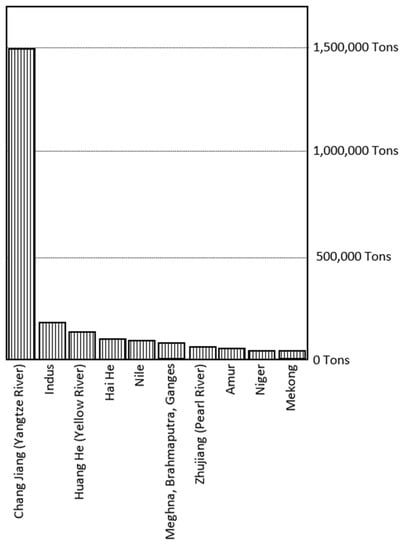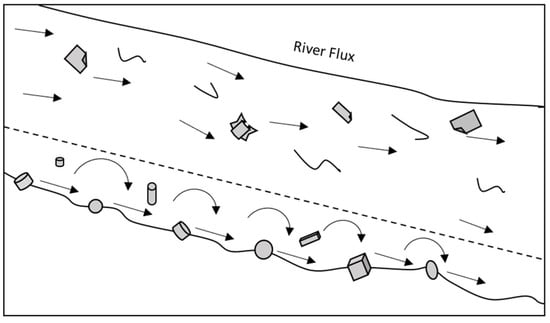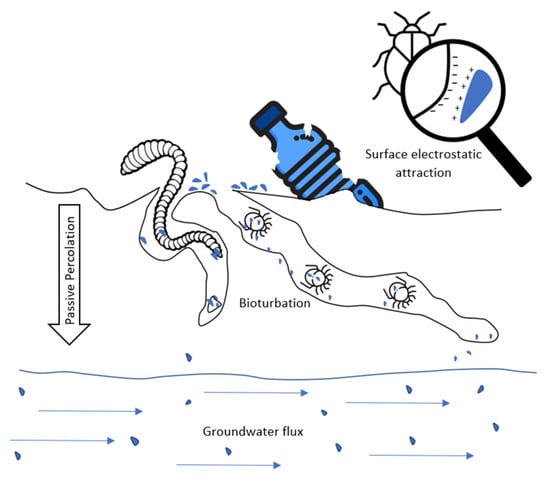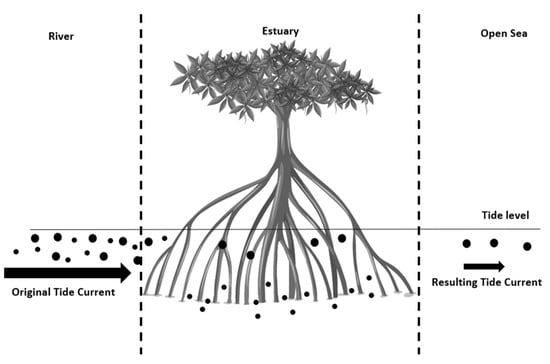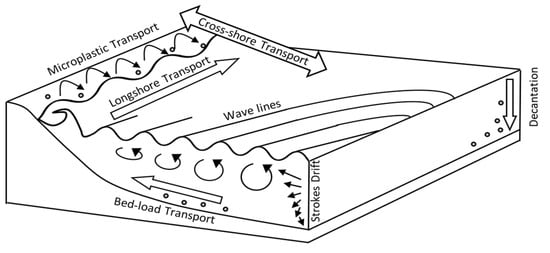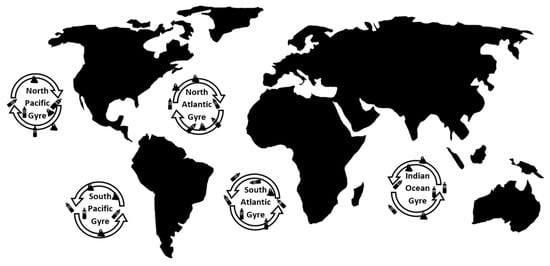1. Microplastic Sources
In the worst case, 42% of human plastic residue production is maintained and stored on land, with a considerable fraction in landfills, often under poorly managed conditions [
1]. Additionally, onshore sources, different from aquatic environments, may produce secondary microplastic particle wastes at a higher rate, since in dry environments, plastic is exposed to more intense weathering degradation, higher temperatures, and exposure to UV radiation. Similarly, use in homes, industry, and transportation represent significant sources of secondary microplastic particles associated with everyday products. For instance, laundry waste, paint, and car tires have been suggested as important sources of secondary microplastic particles on land [
25,
26,
27,
28] and potentially loaded through punctual or diffuse paths along riverside and coastal areas, with a global trend to find more plastic microparticles in the vicinity of densely populated coastal areas [
29]. Based on this information, and on much research about plastics in estuaries, it is not a mistake to consider that land sources are the major origin of microplastics in the aquatic environment [
30]. For instance, Andrade (2011) [
9] suggested that 80% of the microplastic found in the sea originates from terrestrial sources. Jambeck et al. (2015) [
1] estimated that usage and waste account for a fraction of between 1.5 and 4.5% of human plastic production that is released directly to marine ecosystems. So, although microplastics can potentially reach coastal environments from both land and sea because of accidental spills during storage or shipping processes, they can either be released from residential and industrial wastes [
31], or swept into rivers, estuaries, and the sea by riverine transport or stormwater runoff diffusion transport [
24].
On the other hand, in environments not so studied, the underground reservoirs include wastewater, litter, atmospheric deposition, and soil and surface water pollution as potential sources of plastic microparticles. Atmospheric agents such as wind, rain, or snow precipitation promote microplastic particle distribution over long distances [32]. So, according to the hydrogeological cell, atmospheric water contribution is the main source of aquifer recharge. Contents of microplastic particles were recorded in precipitation along cities and remote areas by some authors [32], reinforcing the ubiquitous nature of these contaminants, being recorded globally from mountaintops [33] to seafloors [7].
A wide number of studies have tried to project the preferential presence of microplastic particles based on their particular aspects in confrontation with the local characteristics of the aquatic systems [
34,
35,
36,
37,
38]. In aqueous environments, microplastic particle transport and subsequent dispersion are dictated by physical hydrodynamic aspects. On the other hand, particle mobility varies as a direct effect of its particular characteristics in response to environmental stimuli. [
39,
40].
2. Characteristics of Microplastics That Influence Their Transport Dynamics
Microplastic particles are extremely variable in both their composition and physical form, due to their variable sources and the weathering actions to which they are exposed during all of their existence [
41]. They present high heterogeneity in composition and resulting buoyancy behavior, depending on their physical properties, such as particle density, shape, and size [
20,
21,
22,
42], directly influencing their transport through any environmental path. Initially, density represents one of the priority factors to be considered when dealing with fluctuation and diffusion through the aqueous medium [
41]. The plastic raw material density varies from <0.05 g cm
−3 for polystyrene foam to 2.1–2.3 g cm
−3 for polytetrafluoroethylene [
43]. Its variation strongly impacts the microplastic particles distribution along the environment; densities under seawater typical values result in particle buoyancy or floating through the water column with neutral density [
44,
45]. For instance, a significant number of authors recorded predominant amounts of polyethylene (PE), polypropylene (PP), and polystyrene (PS) in surface waters [
46,
47,
48].
On the other hand, higher densities determine deposition in aquatic environments. Low-density polyolefin plastic microparticles, for example, tend to float under lentic hydrodynamic patterns. Other plastic matrices, on the other hand, such as nylon, polyethylene terephthalate (PET), or polyvinylchloride (PVC), with different compositions and resulting higher densities, should decant and deposit in sediments under the same environmental conditions [
49].
In a similar way, plastic microparticle shapes influence their mobility. So, based on the settling differences dictated by different microplastic particle shapes, Rodríguez-Seijo and Pereira (2017) [
50] categorized them into three groups (
Figure 1): monodimensional (fibers, lines), bidimensional (films, flakes, flat thin particles), and three-dimensional (3D) (irregular fragments, pellets, ovoids, cylinders, and spherules) classes. For instance, microplastics presenting fibrous or filmous aspects hardly decant through the water columns, being more bioavailable in all subsurface layers of the aquatic water system. Three-dimensional forms, on the other hand, show a greater capacity to settle. Jung et al. (2021) [
51], through their ecotoxicological assays of microplastics in different coastal environments, recorded that non-three-dimensional particles presented a higher chance to be assimilated than spherical ones. The same authors found that non-three-dimensional particles presented a higher abundance in coastal waters than in open oceanic water.
Figure 1. Characteristics of microplastics that influence their transport dynamics.
Finally, another characteristic that can strongly influence microplastic particles’ diffusion and consequent dispersion is size. According to the available literature, microplastic particles vary in a wide range of sizes across all aquatic pools, between 10 μm and 5 mm [
52,
53]. Comparing microplastic particles with natural mineral particles, a range size of 5 mm, the upper size limit for microplastic particles, corresponds to the size of fine gravel, while a range of 10 μm is equivalent to the mineral silty grain. Scientific sedimentation studies use grain size as one of the main aspects to keep in mind as a controller of sediment movement, even in aquatic environments [
54,
55].
Despite this similarity between the fields, not all research related to microplastics uses granulometry as an evaluation criterion. The reason may lie in the variations in hydrodynamic behavior patterns imposed by the wide variation in compositions and textures presented by plastic microparticles, which are still not fully understood by the scientific community. Filella (2015) [
56] was the first author to highlight the lack of attention to standardized size classification and its importance, using the sediment analogy.
Laboratory simulations performed by some researchers evaluated and tried to correlate plastic microparticles’ physical and chemical aspects and their impacts on deposition processes [
22,
43]. Ballent et al. (2012) [
21] experimentally compared the settling speeds of pellets with three different densities, under seawater values. The authors proved that settling velocity increased with higher density most of the time. According to the same authors, not just the density, but also the shape directly impacts the sinking rate. The assay performed in the study indicated a higher sinking rate of polyamide (1.14 g cm
−3) than polyvinyl chloride (1.56 g cm
−3), which suggested that the shape of the plastic microparticle significantly impacts its decanting speed [
22]. Results found by Sagawa et al. (2018) [
57] reinforced this theory, finding that the average size of microplastics in bottom sediments was significantly smaller than that of deposited particles.
The biota’s impact on the microplastic diffusion dynamic cannot be ignored. So, not just the shape but also the size of plastic microparticles contribute to the trophic incorporation of these pollutants. Particle color is considered another physical property that impacts its rate of assimilation at different trophic levels. Darker colored particles tend to attract predators in a more effective way, mimetizing their original prey [
58]. During the time that plastic remains in the environment, its original characteristics tend to change due to several factors. Under ultraviolet light exposure for a long time, plastic tends to change to a less plastic and more brittle character [
59]. At the same time, smaller particles are potentially assimilated by microbiota and subsequently ingested by bigger organisms during trophic chain evolution [
60].
Other factors must be taken into account when projecting the settling potential of microplastic particles: low-density plastic microparticles may be stimulated to sink due to biofouling and resulting aggregation with other particles, increasing the density/volume ratio [
7,
61,
62,
63,
64]. Microbiota can rapidly colonize the surface of plastic particles through biofilm development [
9,
65]. Cózar et al. (2014) [
66] suggested that the biofouling process shows the capacity to increase microplastics’ densities, making particles lighter than seawater decant under seawater conditions. Similar results were found by Morét-Ferguson et al. (2010) [
64] in the western North Atlantic. On the other hand, biofilms are able to decrease the hydrophobicity of the plastic matrix, stimulating microparticles to sink [
63], and permitting compounds such as polyethylene and polypropylene, to accumulate under marine sediments. For instance, Chubarenko et al. (2016) [
43] recorded that heavier particle microparticles take more than 18 h to decant in the central Gotland Basin (250 m). On the other hand, in the same study, authors reported that polyethylene fibers spend about 6–8 months in the lightning depth before settling on the floor because of biofouling.
Additionally, the organic aggregates attaching process represents another potential in which lighter particles have their decanting capacity stimulated [
7]. Long et al. (2015) [
8] promoted, under laboratory conditions, the incorporation of diatom aggregates with polystyrene microbeads. The results showed an increase of orders of magnitude in the decanting ratio of the used plastic microparticles.
3. Riverine Transport
Once plastic particles arrive in an aqueous environment, water flux acts as a vehicle distributing and spreading the particles throughout its course. According to some authors, around the globe, rivers are responsible for the discharge of about 1.2–2.4 MT per year, of plastic pollutants from terrestrial areas to oceans [
66,
67]. In this context, 10 major rivers discharge the biggest part of the plastic residues to the oceans, reaching, according to some authors, 80–90% of the ocean plastic pollution [
68]. The quantity of plastic material that reaches the sea water by each river is shown in
Figure 2 [
69]. This process occurs at different water column depths and riverbed fluxes as well [
70]. Keeping in mind the high levels of microplastics recorded in estuarine ecosystems, these projections can be considered reasonable [
30]. So, based on this information, it can be said that small and medium river contributions are not negligible [
71].
Figure 2. Major river contributing to plastic in oceans [modified from John et al., 2022] [
69].
Significant quantities of microplastics have been reported along riverbeds around the world, suggesting that rivers function not just as pathways but also as potential pools of plastic microparticles [
72]. Under the influence of changing water currents, due to seasonality, for instance, deposited plastic particles on riverbeds can either return to the water column mobilized by the water flow or stay still settled [
70]. On the other hand, floating plastic particles would respond in a different way under the same hydrodynamic conditions (
Figure 3). However, deeper research on the diffusion of varied microplastic types in river sediments is scarce.
Figure 3. Three-dimensional particles migrate preferentially by saltation or dragging movement. Mono and bidimensional particles migrate preferentially by suspension movement, through river flow.
4. Underground Water Transport
Microplastic presence and resulting contamination is still poorly evaluated in underground water systems. Most of the time, studies on plastic microparticle pollution focus only on surface ecosystems. As a result, only a few authors have examined microplastic pollution in caves and underground [
73].
Once deposited on the ground, plastic microparticles can be transferred horizontally by surface carriage, or vertically, through percolation through soil particles, moving across long distances, passing through unconsolidated sediments, rock pores, or fractures, until they reach an aquifer and accumulate [
74,
75] (
Figure 4). Some authors focused on the downward percolation movement of microparticles through soil [
76,
77]. Microplastic particles can diffuse downward to deeper layers in a soil profile with percolating water. This migration process is limited and dependent on the size and shape of microplastics as well as the soil grain size and resulting porosity and permeability. Transport downward is easier through cracks, faults, or macropores [
78]. Where the macropores density decreases the microplastic particles will likely again be blocked in their further downward leaching by the porosity characteristics distribution of the matrix. Although migration of microplastic particles to deeper soil layers is relatively limited and deterioration of buried microplastic particles in soils is considered slow [
79], it is clear that after the natural degradation process and resulting decrease in particle size to the nanoplastics category, the transport of the particles to deeper layers and groundwater becomes faster.
Figure 4. Vectors of microplastic particles for groundwater reservoirs.
Additionally, Lwanga et al. (2017) [
80] studied the bioturbation impact on microplastic soil diffusion. Microplastic particle transportation performed by soil organisms is directly related to the size of both elements: microplastic and biota. Small particles are transported faster than bigger particles. On the other hand, smaller species will also relatively enhance microplastic transportation [
80]. Dong et al. (2020) [
81] suggest the strong electrostatic forces of small plastic debris as stimulators of aggregation among particles and invertebrate species bodies surfaces. So, according to the same authors, this mechanism could explain the microplastic transport capacity of invertebrates through soil pores and cavities, although little data is available to help the understanding of how microplastic transport is impacted by electrostatic attraction between microplastic particles and invertebrates [
80]. Finally, another kind of microplastic soil transport is performed by earthworms that effectively show the capacity to drag plastic particles into their galleries, transporting them into deeper soil layers.
On the other hand, not just the nature of the soil but the hydrogeological architecture of the basin and seasonal water flux variations must be considered, as well as the water flux of streams and riverbeds. So, hydrogeological diagnosis as well as aquifer types are decisive in the comprehension of the migration ratio and flux of microplastic in underground water environments.
5. Estuarine Transport
Estuarine ecosystems consist of transitional sites between land and oceanic waters. As a result, drastic variation in the water column happens because of the different densities of the water contacts [
82,
83]. The mixture and resulting stratification processes between the saline and freshwater could potentially impact the migration of buoyant microplastic particles. Still, the strong tidal currents may impact their residence time and transport processes between high and low tides [
84,
85].
Once present in estuarine waters, the particles may be dispersed throughout all compartments. Through the saline wedge, low-density plastics generally tend to submerge [
2]; smaller particles are carried by the flow of water and settle where water movements are less intense [
86], such as in intertidal flats and mangrove swamps [
87].
Plastic fragments reach estuarine environments either by land runoff or from the ocean through wind, waves, and tidal currents [
88]. Microplastics trapping or accumulation in estuarine environments such as salt marshes or mangroves has been richly documented [
89,
90,
91,
92].
With their highly complex hydrodynamics, estuaries can act as natural filters to selectively trap particles [
84]. The efficient trapping character of estuarine environments is due, in part, to the existence of many macrophyte or mangrove plant species that contribute to decreasing the current flux across the aquatic compartment. Especially in some spots of the estuary, the smaller transport competence stimulates floating particles to decant and accumulate in the fine-grained muddy bottom (
Figure 5). Some authors suggested that typical estuarine flora together with tide fluxes work as potential microplastics retainer within estuarine systems [
93,
94]. For instance, mangrove forest specimens, presenting their pneumatophores, promote the current blockage, stimulating the accumulation of microplastic particles in sediments. Since the decantation of plastics is size dependent, small plastic particles tend to sink downward to the estuarine floor, while larger particles preferentially stay afloat in surface waters for a longer period [
95].
Figure 5. Mangrove forest specimens working as microplastic traps.
Estuarine water tends to be a highly productive environment. Because of the eutrophic character of the water, a variety of fouling biota, such as algae or invertebrate species, may potentially attach to buoyant microplastics, increasing their weight and resulting decantation capacity [
2,
96,
97,
98]. Once they hit the estuarine floor, some of them can be covered by sediment, undergo the process of physical, chemical, and biological deterioration, and finally be buried, accumulating in the environment for a long period [
99]. On the other hand, depending on their size, they can be incorporated into the food chain by benthic and demersal biota [
100,
101,
102,
103]. Under stormwater hydrodynamic change, the deposited particles can be remobilized and migrate to the open sea.
6. Sea Coast Transport
Beaches are those environments that deserve our attention regarding microplastic particles contamination. Being an extremely dynamic ecosystem resulting from the interaction between physical agents (waves, tides, longshore currents) [
104] these environments represent the habitat to a variety of species that are extremely mobile and adaptable to variable site conditions [
105]. Additionally, beaches are generally subjected to intense recreational activities that generate large amounts of plastic litter.
A wide range of articles have recorded microplastic contamination on beach surfaces worldwide, and alarming levels of microplastic particles have been announced [
106,
107,
108,
109,
110]. The amount of microplastic particles recorded on sandy beaches varied in different studies, ranging from 1 piece/kg d.w. to more than 2000 pieces/kg d.w [
111,
112,
113].
Most of the research discusses the abundance and distribution of microplastic particles in beach sand. On the other hand, cross-shore distribution of microplastic particles on beaches [
39] or even microplastic particles behavior along coastal waters has received less focus [
114]. Understanding microplastic particles’ vertical distribution is fundamental to understanding the diffusion of these pollutants along the beach environment.
Along nearshore shallow waters, the physical hydrodynamics dictating microplastic particles migration is expected to be mainly impacted by the effect of shallowing bathymetry, which is responsible for strong changes of the wave pattern and resulting currents production. Coastal waters are considered a temporary deposit for plastics because of the local hydrodynamics promoting onshore transport [
85,
115]. Still, nearshore zones can also function as sources of plastics in the open ocean [
116], especially during extreme events [
117].
Most plastic bodies have a density smaller than seawater, resulting in their floating, and maintaining them in the surface strata of the water column of the sea [
44]. Thus, their diffusion and consequent distribution in the oceans are mainly associated with the hydrodynamic cell in which the body is located. A large part of the littoral sediment transport occurs in the swash zone, both cross-shore and longshore, which influences particle sedimentation. On the other hand, the microplastic particles that drift within and out of the surf zone are, again, strongly influenced by the particles’ physical compositional properties [
118], which impact their distribution dynamics in the coastal zone [
119]. A significant group of microplastic particles presents a high buoyancy capacity. Therefore, they tend to reach the open sea area, being towed by the resultant force resulting from the sum of surface currents, strokes drift, and mesoscale eddies [
120].
The diffusion and accumulating dynamic of microplastic particles along beach ecosystems is dictated by the same parameters and dynamism that transports natural sediment particles [
121,
122]. On the other hand, the density of plastic particles, on average, varies from 0.9–1.4 g cm
3, while the density of natural beach sediment varies around 2.65 g cm
3 [
123]. This aspect can make the distribution patterns of microplastic particles more difficult to predict.
Beach sediment, located in the surf zone, is governed by an extremely complex hydrodynamic balance. It is temporarily moved/distributed by climate and resulting currents across and along the shoreline, responsible for the formation of subaquatic sandbars, which in turn influence wave breaking dynamics and further increase the dissipation of wave energy [
124]. Basically, the surf zones are geomorphologically unstable, and are constantly reshaped by wave action.
Gradually, as waves approach the shallow coastal water, the bottom increasingly imposes wave transformations (shoaling and refraction) (
Figure 6), reflecting the velocity drift and direction of wave propagation known as the Stokes drift [
125]. This effect is stronger in the upper water layers, decreasing along the water column, even resulting in opposite currents near the bottom (i.e., offshore drift). In addition to these nearshore current systems, water turbulence resulting from wave breaking in the swash zone causes intense sediment mobilization within the surf zone. So, in the surf zone, sediment can be transported in three ways: as bottom drag, in suspension, and by sheet flow movement [
126]. As the characteristics of plastic microparticles differ from those of natural sediments, these elements react to these hydrodynamic processes and wave-induced flow forces similarly but not completely identically to natural sediments. Forsberg et al. (2020) [
123] performed a modeling assay and found that heavier plastic particles are expected to present similar diffusion patterns such as natural sand, preferentially accumulating in the breaking zone. Still, the same authors suggested that lighter microplastic particles are more effectively moved by onshore or offshore winds, being more easily exported to other environments such as the open sea or back to the continent.
Figure 6. Schematic diagram of longshore microplastic diffusion mechanisms (modified from Critchell and Lambrechts, 2016) [
127].
7. Oceanic Transport
Eriksen et al. (2014) [
128] suggest that there are more than five trillion plastic pieces floating in the oceans, representing more than 250,000 tons of plastic circulating. Once at the open sea, the distribution of plastic microparticles through the water column, unlike the floating particles, presents a greater complexity in its distribution, which aroused the curiosity of the scientific community. According to Kanhai et al. (2018) [
129], there is a vertical pattern distribution, between 8 and 4369 m depth, in the Arctic Central Basin. Through their investigations, the authors recorded an increase in fragments in the mixing layer depth. Wind currents and geostrophic circulation participate in this stratification process, resulting in patterns that determine convergent zones of particles located in the so-called “subtropical gyres” [
130,
131] (
Figure 7). Kukulka et al. (2012) [
44] suggested the great influence of the wind in the turbulence mixing zone, confirming the influence of hydrodynamic cells on the distribution of plastic microparticles. Still, the particular physical features of microplastics make the microplastic vertical distribution through the variable advective flux even more complex [
132], which, in turn, impacts the vertical distribution of these particles. Enders et al. (2015) [
97] evaluated the vertical diffusion of microplastics in open sea water through the water column and confirmed that, in the same way as in other aquatic environments, vertical dispersion is directly impacted by particle size. According to the authors, larger-sized plastic microparticles are significantly less impacted by turbulent mixing. On the other hand, according to a flux modeling study, fibrous-shaped microplastics present a lower speed, followed by sheets and three-dimensional particles [
52].
Figure 7. Oceanic gyres concentration plastic particles.
Finally, the particle density shows the influence capacity in whatever compartment it is present: surface waters, water columns, shallow sea bottoms, or deep-sea sediment [
133]. High-density microplastics present low buoyancy, resulting in their deposition on the seafloor [
134]. As a result, there is a great chance that the absolute majority of microplastic that reached the ocean remained there [
135] since plastic particles do not deteriorate completely, being just turned into smaller particles [
136].
This entry is adapted from the peer-reviewed paper 10.3390/microplastics2010005

